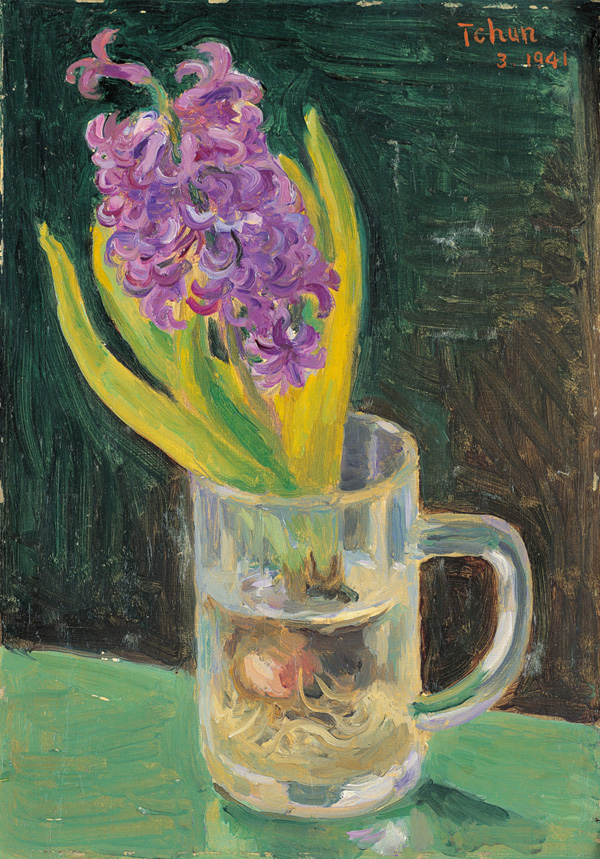Born into a wealthy Shanghai family, with ancestry hailing from Guangdong, Chen Baoyi (Po Yi Tchun) was the first generation of Chinese oil painters to study in Japan. He was also the pioneer of the new fine arts movement in China. Having witnessed the progress in the developments of western painting in China, he made it his lifelong ambition to reform oil paintings. He set up a western art academy and research institute to educate the young. Members of the "Jue Lan Society"Yang Qiuren, Yang Taiyang and the female oil painter Guan Zilan, were all among his favourite disciples.
China in the early 20th Century was ravaged by war. Chen Baoyi experienced the frustrating hardships of going from riches to rags, yet his paintings continued to maintain their usual elegance. Having studied thirty years of innovations in western paintings, most of the subjects primarily involved depicting the pleasures of living such as still lifes and figures. In 1938, he even completed two books titled "Study of Still-life Paintings"and "Study of Figure Paintings"that were published by Commercial Press, establishing the foundations for developments in early Chinese oil paintings.
Shen Zhiyu, who had served as assistant director in the Shanghai Museum during his earlier days, recalled visiting Chen Baoyi's Shanghai residence during the 1930s, "the interiors were very clean, flowers were kept in a vase, on the wall was a still-life oil painting completed by Mr Chen Baoyi himself."(see Chen Jui-lin ed. Modern Artist, Chen Baoyi People's Fine Arts Publishing House, Beijing, September 1988, p.158). The "Chen's family garden" then a building constructed in a western style, has since been destroyed in the Shanghai Incident. Life became bland and the financial situation a struggle but still he managed to find his own joy. The lifestyle of cultivating flowers, painting and studying ancient books had become the manner in which he molded his own temperament and character. His Japanese friend Saburo Kikuchi pointed out that Chen Baoyi loved to paint flowers and plants and felt deep sentiments towards the beautiful flora. In an article that he published, "Restraint in Art and The Advancement of Social Living" Chen Baoyi advocated that besides the survival instincts of a primitive age we should think of tasteful interests and noble thoughts. Though self restraint through art isn't the only way, it is helpful in assisting the advancement of society. Chen also highlighted that the quality of one's character equals the quality of one's painting; only with good morals can one be capable of churning out fine paintings. Hence, integrating art into one's tastes in living can be flavorful even if one is poor.
"The brief life that Chen Baoyi had left many wonderful works behind for later generations, including landscapes, still lifes and portraitures, such as "Dawn Breaking, Su Causeway" "Hong Kong Harbour" "Scenery, Western Shanghai" "H yacinth" "Flower, Chinese Rose" "Portrait, Master Hong Yi" "Artist Guan Zilan"etc. The colors and brushwork in his oils are strong and forceful, seemingly revealing his pioneering spirit as a forerunner. Such robust painting styles did not go away even during the destitute state in the later periods. Chen Baoyi advocates starting from skilled realistic techniques in order to develop new artistic styles and not by mechanically imitating the forms of western schools of modern art."(see Juan Jung-chun, Hu Kuang-hua, "Contemporary Chinese Art History, 1911-1949" Commercial Press, Hong Kong, 1997, p.143. )
The 1941 "Hyacinth"is a small delicate painting featuring a violet hyacinth kept in a glass. Using green as the base color, harmonious segregation of space is formed by varying different colors. Strings of flowers in a profusion of colors adorn the brilliance of spring during March. In western flower lingo, hyacinth represents "As long as the fire of life is lit, a rich and sumptuous life can be shared.?A bulb in a cup with little water, despite the harsh and restraining environment, can still have the most dazzling of flowers bursting into full bloom. Perhaps, in Chen Baoyi's mental state in the later part of his life, it was this love for life and the humanitarian concern for the post war traumas that continued to support his artistic creations. Painter Feng Zikai rated Chen's works very highly and was particularly in admiration with his small painting, judging it to be a rare piece of exquisite art (see "M odern Artist, Chen Baoyi? p.198.). It seems simple to work on a small painting, but figuring out how to render a mood of vastness and room for imagination within a tiny space is probably not something achievable by most artists. Apparently, Chen Baoyi's "Hyacinth"is a piece of work exuding extraordinary talent that deserves to be well and thoroughly appreciated.
